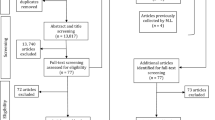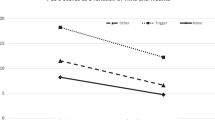Abstract
In phallometric research, rapists have a unique pattern of erectile responses to stimuli depicting sexual activities involving coercion and violence. In this study, we attempted to determine the cues that control rapists’ erectile responses to rape stories in the laboratory. A total of 12 rapists and 14 non-rapists were exposed to recorded audio scenarios that systematically varied with regard to the presence or absence of three orthogonally varied elements: sexual activity and nudity, violence and injury, and expression of non-consent. As expected from prior research, an index computed by subtracting participants’ greatest mean responses to stories describing mutually consenting sexual activity from their greatest mean responses to stories describing rape was much higher among rapists than non-rapists. Both groups showed larger responses when stories involved sexual activity and nudity, but neither group exhibited a preference for cues of violence and serious injury, or for cues of non-consent. The element that produced the larger group difference, however, was the presence or absence of active consent. The results indicated that a sexual interest in (or indifference to) non-consent is at least as central to accounting for the unique sexual orientation of rapists as is sexual responding to violence and injury.


Similar content being viewed by others
References
Barbaree, H. E., Marshall, W. L., & Lanthier, R. D. (1979). Deviant sexual arousal in rapists. Behaviour Research and Therapy, 17, 215–222.
Baxter, D. J., Barbaree, H. E., & Marshall, W. L. (1986). Sexual responses to consenting and forced sex in a large sample of rapists and non-rapists. Behaviour Research and Therapy, 24, 513–520.
Bernat, J. A., Calhoun, K. S., & Adams, H. E. (1999). Sexual aggressive and nonaggressive men sexual arousal and judgments in response to acquaintance rape and consensual analogues. Journal of Abnormal Psychology, 108, 662–673.
Blanchard, R., Lykins, A. D., Wherrett, D., Kuban, M. E., Cantor, J. M., Blak, T., et al. (2009). Pedophilia, hebephilia, and the DSM-V. Archives of Sexual Behavior, 38, 335–350.
Dunkel, C. S. (2011). The effect of individual differences and manipulated life expectancies on the willingness to engage in sexual coercion. Evolutionary Psychology, 9, 588–599.
Freund, K. (1990). Courtship disorder. In W. L. Marshall, D. R. Laws, & H. E. Barbaree (Eds.), Handbook of sexual assault: Issues, theories, and treatment of the offender (pp. 195–207). New York: Plenum.
Freund, K., & Blanchard, R. (1989). Phallometric diagnosis of pedophilia. Journal of Consulting and Clinical Psychology, 57, 100–105.
Hare, R. D. (2003). The Hare Psychopathy Checklist-Revised. Toronto: Multi-Health Systems.
Harris, G. T., Lalumière, M. L., Seto, M. C., Rice, M. E., & Chaplin, T. (2009, October). Rapists’ sexual responses to phallometric stimuli emphasizing serious injury to victims. Paper presented at the meeting of the Association for the Treatment of Sexual Abusers, Dallas, TX.
Harris, G. T., Rice, M. E., Chaplin, T. C., & Quinsey, V. L. (1999). Dissimulation in phallometric testing of rapists’ sexual preferences. Archives of Sexual Behavior, 28, 223–232.
Harris, G. T., Rice, M. E., Hilton, N. Z., Lalumière, M. L., & Quinsey, V. L. (2007). Coercive and precocious sexuality as a fundamental aspect of psychopathy. Journal of Personality Disorders, 21, 1–27.
Harris, G. T., Rice, M. E., Quinsey, V. L., Chaplin, T. C., & Earls, C. M. (1992). Maximizing the discriminant validity of phallometric assessment. Psychological Assessment, 4, 502–511.
Lalumière, M. L., Harris, G. T., Quinsey, V. L., & Rice, M. E. (2005). The causes of rape: Understanding individual differences in the male propensity for sexual aggression. Washington, DC: American Psychological Association.
Lalumière, M. L., Mishra, S., & Harris, G. T. (2008). In cold blood: The evolution of psychopathy. In J. Duntley & T. K. Shackelford (Eds.), Evolutionary forensic psychology (pp. 176–197). New York: Oxford University Press.
Lalumière, M. L., & Quinsey, V. L. (1993). The sensitivity of phallometric measures with rapists. Annals of Sex Research, 6, 123–138.
Lalumière, M. L., & Quinsey, V. L. (1994). The discriminability of rapists from non-sex offenders using phallometric measures: A meta-analysis. Criminal Justice and Behavior, 21, 150–175.
Lalumière, M. L., Quinsey, V. L., Harris, G. T., Rice, M. E., & Trautrimas, C. (2003). Are rapists differentially aroused by coercive sex in phallometric assessments? Annals of the New York Academy of Sciences, 989, 211–224.
Lohr, B. A., Adams, H. E., & Davis, J. M. (1997). Sexual arousal to erotic and aggressive stimuli in sexually coercive and noncoercive men. Journal of Abnormal Psychology, 106, 230–242.
Looman, J. (2000). Sexual arousal in rapists as measured by two stimulus sets. Sexual Abuse: A Journal of Research and Treatment, 12, 235–248.
Lykins, A. D., Cantor, J. M., Kuban, M. E., Blak, T., Dickey, R., Klassen, P. E., et al. (2010). Sexual arousal to female children in gynephilic men. Sexual Abuse: A Journal of Research and Treatment, 22, 279–289.
Marques, J. K. (1981). Effects of victim resistance strategies on the sexual arousal and attitudes of violent rapists. In R. B. Stuart (Ed.), Violent behavior: Social learning approaches to prediction, management, and treatment (pp. 138–172). New York: Brunner/Mazel.
Quinsey, V. L. (2010). Coercive paraphilic disorder. Archives of Sexual Behavior, 39, 405–410.
Quinsey, V. L., & Chaplin, T. C. (1982). Penile responses to nonsexual violence among rapists. Criminal Justice and Behavior, 9, 372–381.
Quinsey, V. L., & Chaplin, T. C. (1984). Stimulus control of rapists’ and non-sex offenders’ sexual arousal. Behavioral Assessment, 6, 169–176.
Quinsey, V. L., Chaplin, T. C., & Upfold, D. (1984). Sexual arousal to nonsexual violence and sadomasochistic themes among rapists and non-sex-offenders. Journal of Consulting and Clinical Psychology, 52, 651–657.
Quinsey, V. L., Chaplin, T. C., & Varney, G. W. (1981). A comparison of rapists’ and non-sex offenders’ sexual preferences for mutually consenting sex, rape, and physical abuse of women. Behavioral Assessment, 3, 127–135.
Quinsey, V. L., & Lalumière, M. L. (1995). Evolutionary perspectives on sexual offending. Sexual Abuse: A Journal of Research and Treatment, 7, 301–315.
Rice, M. E., Chaplin, T. C., Harris, G. T., & Coutts, J. (1994). Empathy for the victim and sexual arousal among rapists and non-rapists. Journal of Interpersonal Violence, 9, 435–449.
Rice, M. E., & Harris, G. T. (2005). Comparing effect sizes in follow-up studies: ROC, Cohen’s d and r. Law and Human Behavior, 29, 615–620.
Rice, M. E., Harris, G. T., & Quinsey, V. L. (1990). A followup of rapists assessed in a maximum security psychiatric facility. Journal of Interpersonal Violence, 5, 435–448.
Seto, M. C. (2008). Pedophilia and sexual offending against children: Theory, assessment and intervention. Washington, DC: American Psychological Association.
Seto, M. C. (2012). Is pedophilia a sexual orientation? Archives of Sexual Behavior, doi:10.1007/s10508-011-9882-6.
Seto, M. C., & Barbaree, H. E. (1993). Victim blame and sexual arousal to rape cues in rapists and nonoffenders. Annals of Sex Research, 6, 167–183.
Seto, M. C., & Kuban, M. (1996). Criterion-related validity of a phallometric test for paraphilic rape and sadism. Behaviour Research and Therapy, 34, 175–183.
Seto, M. C., & Lalumière, M. L. (2001). A brief screening scale to identify pedophilic interests among child molesters. Sexual Abuse: A Journal of Research and Treatment, 13, 15–25.
Seto, M. C., Lalumière, M. L., Harris, G. T., & Chivers, M. L. (2011). The sexual arousal of sexual sadists: A phallometric study. Manuscript submitted for publication.
Sims-Knight, J.E., & Guay, J. (2011, November). Is PCD a construct distinct from sadism? Paper presented at the meeting of the Association for the Treatment of Sexual Abusers, Toronto.
Thornton, D. (2010). Evidence regarding the need for a diagnostic category for a coercive paraphilia. Archives of Sexual Behavior, 39, 411–418.
Wakefield, J. C. (1992). Disorder as harmful dysfunction: A conceptual critique of DSM-III-R’s definition of mental disorder. Psychological Review, 99, 232–247.
Acknowledgements
We wish to acknowledge the financial support of the Social Sciences and Humanities Research Council of Canada (Standard Research Grant awarded to the first four authors), and the useful suggestions provided by Samantha Dawson, Meg Ebsworth, Vern Quinsey, and Kelly Suschinsky. A version of this article was presented at the University of Lethbridge Workshop, The Puzzle of Sexual Orientation: What Is It and How Does It Work?, Lethbridge, Alberta, Canada, June 2010.
Author information
Authors and Affiliations
Corresponding author
Rights and permissions
About this article
Cite this article
Harris, G.T., Lalumière, M.L., Seto, M.C. et al. Explaining the Erectile Responses of Rapists to Rape Stories: The Contributions of Sexual Activity, Non-Consent, and Violence with Injury. Arch Sex Behav 41, 221–229 (2012). https://doi.org/10.1007/s10508-012-9940-8
Published:
Issue Date:
DOI: https://doi.org/10.1007/s10508-012-9940-8




